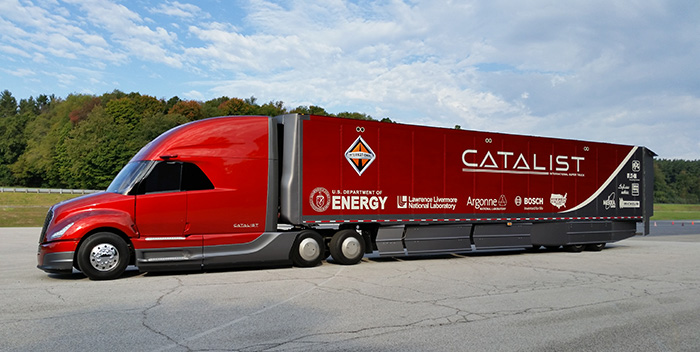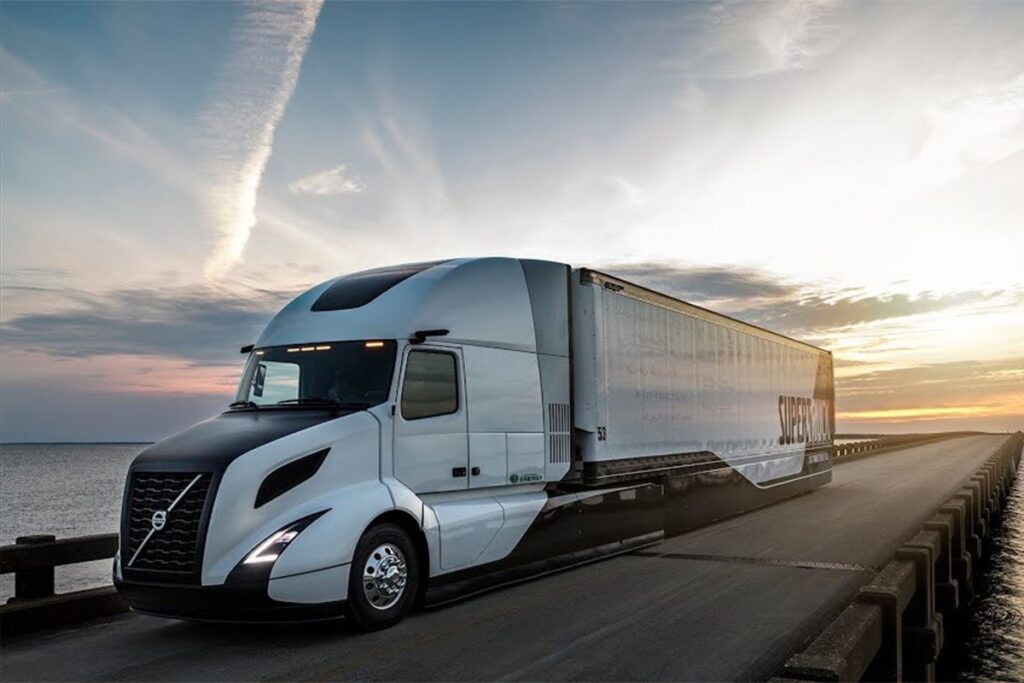The landscape of global transportation is undergoing a seismic shift, and at the forefront of this revolution are supertrucks. These colossal vehicles, equipped with cutting-edge technology and innovative design, are reshaping the logistics industry and challenging the conventional norms of freight transport. The surge in demand for faster and more efficient freight movement, coupled with advancements in technology, has paved the way for the rise of these behemoths on our highways. In addition to cargo, a wide range of conveniences in travel opens up, the opportunity to rent an RV in Key West and enjoy your vacation as if you were in a comfortable apartment.
The Need for Change

For decades, the transportation industry has grappled with inefficiencies and limitations inherent in traditional trucking models. The highways congested with freight traffic, coupled with the environmental impact of fuel-inefficient long-haul trucks, have fueled the need for a more sustainable and efficient solution. Supertrucks represent a paradigm shift in how goods are transported across vast distances, addressing the urgent demand for a transformation in the logistics sector.
The advent of e-commerce has added a new layer of urgency to this call for change. With the exponential growth of online shopping, the demand for quick and reliable transportation of goods has soared. Supertrucks, with their enhanced capacity and streamlined design, emerge as a strategic solution to meet the evolving demands of a globalized economy. Their ability to carry larger loads and optimize delivery routes positions them as key players in the logistics ecosystem, catering to the growing needs of businesses and consumers alike. At the same time, a wide range of new entrepreneurs are emerging with their ideas who need companies to sell their businesses to.
Moreover, the need for change goes beyond the surface-level challenges. It extends to the very core of how we perceive transportation and the role it plays in our interconnected world. Supertrucks, with their capacity for increased efficiency and reduced environmental impact, offer a transformative solution that aligns with the evolving expectations of a society increasingly conscious of its ecological footprint. Aware of the overall pollution in the city, more people are interested in their own houses, oases of peace like the houses in Boca Raton.
Technological Marvels: Powering the Supertruck Revolution
At the heart of the super truck revolution lies a convergence of cutting-edge technologies, each contributing to the metamorphosis of these vehicles into intelligent and efficient freight movers. These are not mere enhancements of traditional trucks; they represent a leap into the future of transportation. Advanced telematics, integrated with real-time monitoring systems, empower super trucks to optimize routes, monitor performance metrics, and ensure timely deliveries, marking a departure from the static nature of traditional freight transport. Transmission systems have been completely upgraded and improved, which highlights the transmission service in Buffalo that specializes in repairing and building that part of the system.
The propulsion systems of supertrucks are a technological marvel on their own. Many are embracing electric or hybrid powertrains, signaling a departure from the reliance on traditional fossil fuels. This shift not only addresses concerns about carbon emissions but also positions super trucks as pioneers in environmentally conscious freight transport. The integration of artificial intelligence further amplifies their capabilities, allowing these vehicles to adapt dynamically to diverse driving conditions, optimizing fuel efficiency, and minimizing their overall environmental impact. Managed IT services in San Antonio have made sure that such trucks are constantly provided with the internet that tells their location and can affect the collection of data from the environment to provide the drivers with the most pleasant driving experience.
Additionally, the technological advancements extend beyond the vehicle itself to the broader logistics ecosystem. The implementation of blockchain technology for secure and transparent supply chain management, coupled with the use of IoT devices for cargo tracking and monitoring, creates an interconnected network that enhances the overall efficiency and reliability of freight transport. Equipped with a roadside assistance app that can be used by ordinary citizens in their cars, ensures easy repair of damage and continuation of the transfer of goods in the event of an accident.
Challenges and Controversies
While the promise of supertrucks is vast, their ascent is not without its share of challenges and controversies. The skeptics raise valid concerns about the infrastructure required to support these colossal vehicles and the potential strain on existing transportation networks. The development of charging stations for electric super trucks, in particular, poses a significant challenge that necessitates a comprehensive and forward-thinking approach to infrastructure planning.
Controversies also extend to the potential societal impacts of supertrucks. The integration of autonomous features raises questions about the safety of these vehicles on the road, necessitating thorough testing and regulatory measures to ensure their reliability. Additionally, the widespread adoption of super trucks with autonomous capabilities prompts discussions about the potential displacement of jobs in the trucking industry. Striking a delicate balance between the benefits of super trucks and the potential drawbacks is imperative for their widespread acceptance and integration into the broader transportation ecosystem. Business lawyers from Dubai point out that the advantages of new trucks with conscious and good drivers cannot be a problem.
The environmental impact of super trucks is another facet of the controversy surrounding their rise. While electric and hybrid powertrains reduce emissions during operation, concerns arise about the environmental impact of producing and disposing of batteries. Sustainable practices in the manufacturing and disposal of these components are crucial to ensuring that the environmental benefits of super trucks are not outweighed by their associated costs. Emergency restoration services in Charlotte state the importance of these trucks being able to get to their destination quickly which is very necessary when dealing with broken pipes.

Economic Impacts and Industry Transformation
The advent of super trucks not only reshapes transportation logistics but also triggers a broader economic transformation. Industries reliant on efficient supply chains stand to gain significantly from the enhanced capabilities of supertrucks. Manufacturers, retailers, and consumers alike will experience the ripple effects of faster, more reliable deliveries, fostering economic growth and efficiency across diverse sectors.
The economic impacts extend to the very fabric of the truck manufacturing sector. Companies are making substantial investments in research and development to stay competitive in this new era of transportation. Traditional boundaries between automotive and tech companies are blurring as collaborations and partnerships emerge, propelling innovation in the design and functionality of super trucks. This can also be felt on some cars, which fans can experience if they rent a car in Beograd. This transformative period presents opportunities for companies to redefine their roles in the transportation ecosystem, fostering a spirit of innovation and competition that drives the evolution of super trucks.
Moreover, the economic implications stretch beyond individual companies to national and global economies. The optimization of supply chains facilitated by supertrucks has the potential to create more resilient and adaptable economies. The ability to transport goods more efficiently can contribute to cost savings for businesses, allowing them to allocate resources strategically and promote economic sustainability.
Looking Ahead: Super trucks and the Future of Transportation
As we stand at the cusp of a new era in transportation, the trajectory of super trucks raises intriguing questions about the future of freight transport. Will these colossal vehicles become the standard for long-haul freight, reshaping the very infrastructure of our highways? How will regulatory bodies adapt to the challenges posed by autonomous features and electric propulsion, ensuring the safety and reliability of super trucks on our roads?
The answers to these questions will undoubtedly shape the landscape of transportation for years to come. The continued development of super trucks, coupled with ongoing advancements in technology and infrastructure, holds the potential to redefine the very nature of freight transport. The integration of super trucks into our transportation ecosystem symbolizes a commitment to innovation, efficiency, and sustainability, setting the stage for a future where the movement of goods is not just a logistical challenge but a testament to human ingenuity. You will not have to worry about your appliances that you order because they will surely arrive undamaged, and at the same time if you want to repair your appliances you can look for appliance repair in Washington DC.
In navigating this uncharted territory, one thing is abundantly clear: the road ahead is paved with innovation, and super trucks are steering us toward a future where transportation is not merely about reaching a destination but doing so with unprecedented efficiency, sustainability, and economic vitality.
Societal Shifts: Redefining Travel and Connectivity
Super trucks, with their advanced technology and connectivity features, hold the potential to redefine the way we experience travel. Imagine a world where long-haul journeys become not just a means of transporting goods but an immersive experience. With onboard entertainment systems, augmented reality windows offering panoramic views, and advanced connectivity, super trucks could transform the perception of travel from a necessity to a leisure activity.
This shift has implications not only for the trucking industry but for the broader travel and tourism sector. Super trucks equipped with state-of-the-art amenities could revolutionize the concept of road trips, making them more comfortable and appealing. The journey itself becomes a destination, with travelers opting for extended trips, exploring new routes and landscapes in the comfort of these mobile havens.
The connectivity aspect is not limited to entertainment. Supertrucks could serve as mobile offices, complete with high-speed internet and workspaces, enabling professionals to remain productive during long journeys. This evolution in travel aligns with the growing trend of remote work, offering individuals the flexibility to work while on the move, further blurring the lines between work and leisure. A Colorado Springs SEO company introduced this concept to its employees.
Cultural Impacts: Redefining the Road Trip Narrative
The rise of supertrucks has the potential to reshape cultural narratives surrounding road trips. Traditionally associated with small vehicles and cramped spaces, road trips could evolve into grand adventures with super trucks at the helm. Families, friends, and solo travelers alike might embrace the idea of spacious cabins, personalized travel itineraries, and the freedom to explore vast stretches of terrain at their own pace. Filmmaking courses already organize tourist tours of film studios for participants in this way.
This cultural shift extends to the perception of truck drivers. No longer confined to the stereotype of long hours on the road with minimal comfort, the profession of truck driving could undergo a transformation. With the integration of autonomous features in super trucks, drivers may transition into more supervisory roles, overseeing the vehicle’s operation while enjoying improved working conditions. This change not only enhances the quality of life for truck drivers but also challenges societal perceptions of their profession.
Moreover, supertrucks could become cultural icons, representing a fusion of technological prowess and the spirit of adventure. Imaginative marketing campaigns could turn these colossal vehicles into symbols of freedom, exploration, and the limitless possibilities that come with embracing innovation. The image of super trucks navigating diverse landscapes could permeate popular culture, shaping how we perceive and romanticize the act of travel in the 21st century.
Environmental Considerations: Toward Sustainable Transport Ecosystems
As supertrucks become more prevalent on our highways, the spotlight on environmental considerations intensifies. The initial focus on electric and hybrid powertrains is just the beginning. Future iterations of super trucks might explore alternative energy sources, such as hydrogen fuel cells or advanced biofuels, further reducing their carbon footprint. The quest for sustainability extends beyond the vehicle itself to the entire transport ecosystem.
Infrastructure development plays a crucial role in this pursuit of sustainability. The creation of smart highways equipped with wireless charging capabilities for super trucks, coupled with renewable energy sources powering these charging stations, forms a comprehensive strategy to minimize the environmental impact of long-haul freight transport. Governments and private entities alike could invest in building an infrastructure that supports not only the efficiency but also the sustainability of supertrucks. Companies such as smoke shops, which procure their products from various parts of the country and the world, are especially struggling with this.
Beyond the reduction of emissions, the environmental focus could extend to the materials used in manufacturing supertrucks. Innovations in lightweight and sustainable materials could further enhance their ecological footprint, ensuring that the benefits of these vehicles extend beyond operational efficiency to a holistic commitment to environmental stewardship.
Regulatory Landscape: Navigating the Uncharted Territory

The integration of supertrucks into our transportation ecosystem prompts a reevaluation of regulatory frameworks. As these vehicles incorporate autonomous features, policymakers face the challenge of establishing guidelines that ensure safety while fostering innovation. Striking the right balance requires collaboration between regulatory bodies, industry stakeholders, and the public to address concerns about liability, ethical considerations, and the overall impact on road safety. In addition, you should think about the premises for the protection of such trucks, which are taken care of by access control systems in Philadelphia.
Furthermore, the regulatory landscape must adapt to the evolving nature of freight transport. Traditional models of oversight may prove insufficient in regulating the complex interplay of technology, connectivity, and automation in supertrucks. New frameworks that embrace a proactive and adaptable approach are essential to navigate the uncharted territory presented by these technological marvels.
Conclusion
In conclusion, the trajectory of the super truck revolution unveils a narrative that extends far beyond the confines of traditional transportation. It signifies a profound shift in how we perceive travel, the cultural significance of road trips, and the pivotal role of technology in shaping our future. Supertrucks, with their blend of innovation, sustainability, and connectivity, emerge not only as logistical giants but as transformative agents in our evolving societal and cultural landscapes.
The integration of supertrucks into our daily lives holds the promise of redefining the very essence of travel. No longer confined to the mundane task of moving goods from point A to B, supertrucks open up avenues for immersive and experiential journeys. The potential for onboard entertainment, workspaces, and connectivity transforms the act of traveling into an adventure, offering a glimpse into a future where the journey itself becomes as significant as the destination.
